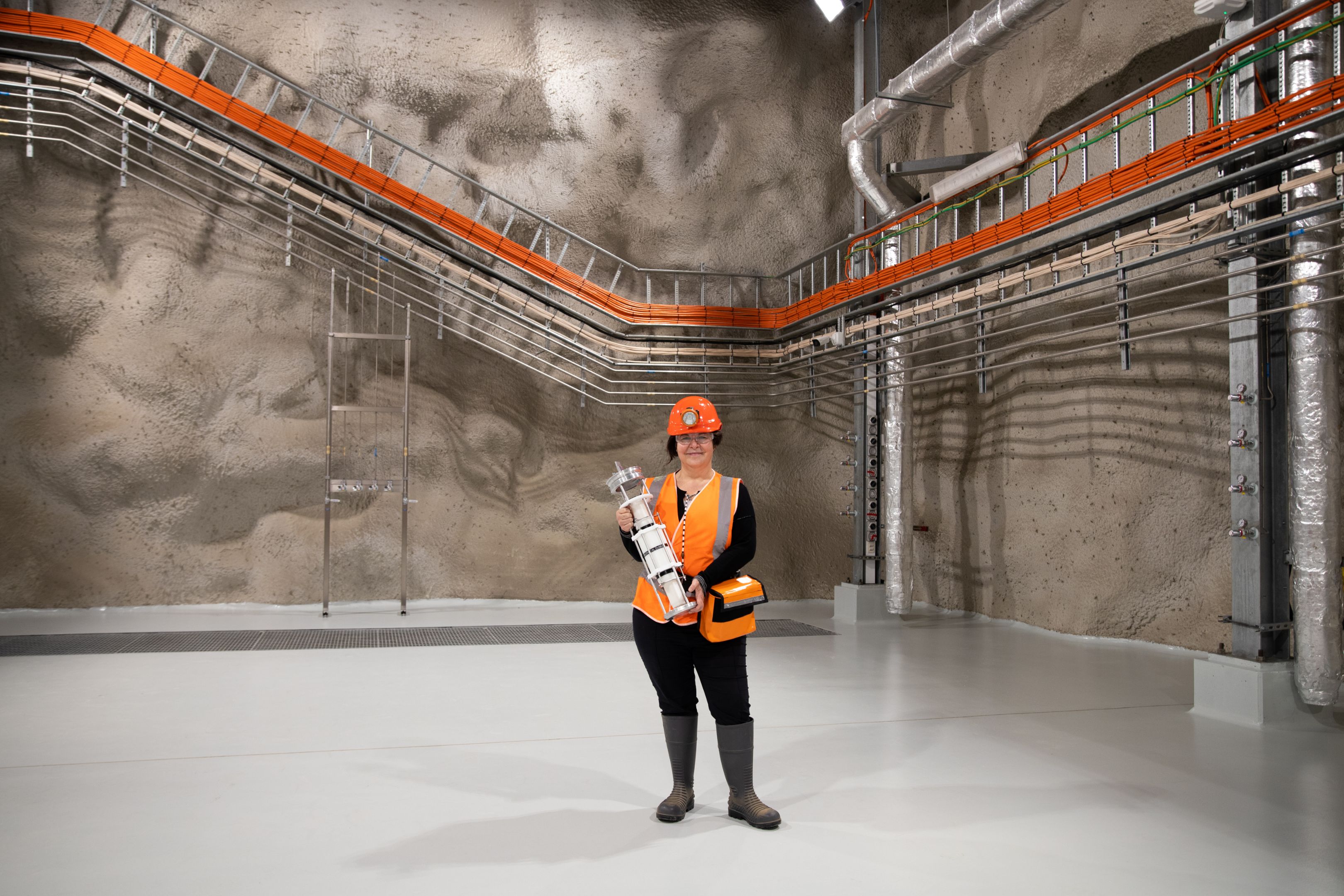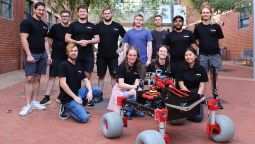Underground lab plunges researchers into the dark (matter)

Researchers visited the Stawell Underground Physics Laboratory as Stage 1 was completed. Credit: The University of Melbourne
In summary
- The Southern Hemisphere’s first dark matter underground physics laboratory has opened
- The lab is located over one kilometre underground, accessible by a 10-kilometre or half hour drive through a maze of tunnels
- Researchers from five institutions will use the Stawell Underground Physics Laboratory to attempt to understand dark matter and unlock the mysteries of the universe
Located one kilometre underground, the Southern Hemisphere’s first dark matter underground physics laboratory is open. The one-of-a-kind lab will allow researchers from several Australian universities to attempt to understand the nature of dark matter and unlock the secrets of our universe.

Lead researcher on the project, Professor Elisabetta Barberio from the University of Melbourne, unveils the Stawell Underground Physics Laboratory
A lab to shine a light in the dark
The first stage of the Stawell Underground Physics Laboratory, located at the active Stawell Gold Mine in the Wimmera region of Victoria, is complete.
It takes half an hour to journey down to the lab site along a 10-kilometre drive through what seems like a maze of tunnels. Once you get there, you find a 33-metre-long by 10-metre-wide lab protected further by a product sprayed on the walls called Tekflex – which reduces the potential for interference from radon gas in the rock mass.
All this to house the SABRE detector (Sodium-iodide with Active Background REjection). With it, researchers will look for visible light emitted as dark matter particles collide with a highly sensitive crystal target.
Professor Alan Duffy, Professor Geoffrey Brooks and Dr Shanti Krishnan – all from Swinburne University of Technology – have been collaborating with scientists from other universities in the design and construction of the SABRE detector, with the main vessel at Swinburne’s Wantirna campus. The components are currently being tested in different facilities around the country before being installed underground in the Stawell Underground Physics Laboratory next year for the first experiment conducted in the lab.
“One of the critical elements developed at Swinburne has a been the ‘slow control system’ developed by a team led by Shanti Krishnan from our Factory of the Future. It is designed to ensure that all the conditions in the SABRE detector are accurately recorded, given the detector is sensitive to small changes in temperature, humidity and movement,” says Professor Geoffrey Brooks.
“It’s exciting that the cutting-edge of physics research is happening right here in Wantirna, just down the road from where I grew up. A boyhood dream has come true!”
Five research institutions will use the Stawell Underground Physics Laboratory to unlock the secrets of the universe, including Swinburne University of Technology, the University of Melbourne, the Australian National University, the University of Adelaide and the Australian Nuclear Science and Technology Organisation (ANSTO).
The Australian and Victorian governments each gave $5 million in funding for the building of the Stawell Underground Physics Laboratory, and this funding was boosted by the Australian Research Council awarding a $35 million grant for the development of a national Centre of Excellence for Dark Matter Particle Physics.
What’s the matter with dark matter?
Dark matter is an invisible and unknown form of mass, which accounts for five times more of the universe than all the atoms, or baryons, we can see. Understanding the nature of this so-called dark matter is one of the greatest challenges in the physical sciences for this century, bringing together astronomers, particle and nuclear physicists in a global hunt.

An animation showing the motion of the galaxy within a vast cloud of dark matter, and the resulting headwind of this material as the Sun travels through it. The Earth’s motion aligns with that direction for half of the year meaning the headwind, and any resulting collisions, increase while the next six months the motion is in the opposite direction so the rate of dark matter through the planet and any dark matter detectors drops in a predictable manner – a signal known as the annual modulation. Credit: CAASTRO
There are many candidates for this collisionless, non-luminous gravitating mass; from ultralight axion particles to weakly interacting massive particles (WIMPs) to even primordial black holes.
At Swinburne, researchers use supercomputer simulations to better predict the distribution of dark matter around visible tracers, such as stars and galaxies, that are then compared with gravitational lensing maps from the Hubble Space Telescope or high-energy emission from potential dark matter self-annihilation signatures as revealed by NASA’s Fermi Gamma-ray Space Telescope.
Director of the Space Technology and Industry Institute and expert in dark matter, Professor Alan Duffy, says that answering ‘what is dark matter?’ has the potential to be one of the most significant discoveries of this century.
“Explaining the nature of dark matter would reveal more of the universe than all of our collective efforts to date, the search is a global race that merges supercomputers, vast telescopes, and enormous underground detectors,” he says.
“Whatever we find will transform our picture of physics in this century as surely as splitting the atom did in the 20th century.”
-
Media Enquiries
Related articles
-

- Astronomy
High school students work with Swinburne astronomers on the future of space
Swinburne’s Youth Space Innovation Challenge has inspired over 330 Australian teenagers to pursue a career in STEM.
Friday 26 July 2024 -

- Astronomy
- Science
Swinburne appoints new Director of Innovative Planet Research Institute
Leading geodesy expert, Professor Allison Kealy, has been appointed as the inaugural Director of Swinburne University's Innovative Planet Research Institute.
Monday 22 April 2024 -

- Astronomy
- University
OzGrav 2.0: A ‘new era of astrophysics’ launched at Swinburne
The next phase in the world-leading ARC Centre of Excellence for Gravitational Wave Discovery, dubbed 'OzGrav 2.0', launched this week at Swinburne University of Technology.
Wednesday 17 April 2024 -

- Design
- Astronomy
- Technology
- University
Swinburne ‘Rock Muncher’ takes part in Australian Rover Challenge
A multidisciplinary student team from Swinburne University of Technology competed in the 2024 Australian Rover Challenge held in Adelaide, South Australia.
Thursday 11 April 2024 -
.jpeg/_jcr_content/renditions/cq5dam.web.256.144.jpeg)
- Astronomy
New JWST observations reveal black holes rapidly shut off star formation in massive galaxies
New research showcases new observations from the James Webb Space Telescope that suggest black holes rapidly shut off star-formation in massive galaxies by explosively removing large amounts of gas...
Tuesday 23 April 2024

